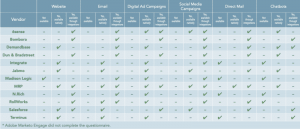
Small businesses have many tools available to them to help reach customers and prospects. They can advertise in traditional newspapers or online. They can send mailers to targeted zip codes or use social media to identify specific interest groups. If your business is going to advertise online, it’s important to understand how it works, and that begins with understanding how Google advertising works. To me, Google’s advertising program, AdWords, functions like a Swiss Army Knife. It has an array of tools which can help businesses reach many different goals in their inbound marketing efforts.
What is inbound marketing?
- Inbound marketing is marketing designed to draw customers to your website or brick and mortar location. Inbound marketing is writing an attention-grabbing blog or e-book for your business. It is creating a video channel on YouTube around what you do. Inbound marketing is essentially the opposite of the marketing approach which has dominated business’ outreach efforts for decades, which is now known as outbound marketing. In outbound marketing you use direct mail or a television ad to push your product or service to a potential customer.
What can inbound marketing do?
- Inbound marketing looks to capture the attention of customers who are already thinking about the product or service your business offers. When someone’s faucet breaks and they go on Google to find a plumber in their area, that can be good news for a plumber with an inbound marketing program in that zip code on Google. The goal of inbound marketing is to capture the attention of your ideal customers. Websites which are adaptive, meaning they function well on desktop and mobile are part of the equation, as is informative content on your website. These efforts create value for your customers and your business.
How can you use inbound marketing to brand your business?
- Google AdWords can help your business’ branding efforts by keeping your brand top of mind when prospective customers are searching online. We’ve used Google AdWords extensively at Bizfi, both in the early days when we were building the business and now that the marketplace for alternative finance has become very crowded. Last fall, when we changed our company name, a Google-based advertising strategy was key to the success of the rebranding. The good news is, it’s extremely effective for small businesses. The bad news? Unlike most of Google’s services, which are free, there is a cost associated with AdWords. You will have to bid on the search terms important to your business in order to have your ad shown when people search for those words. But there are many things you can do to help mitigate the cost:
- Use a keyword planner – Google has a keyword planner that helps you determine what the best search term for your business is. It offers useful statistics on how words have performed for competitors and can help you see how to combine words in ways to be more effective.
- Be an educated keyword bidder – The bidding process is similar to bidding for an item on eBay. The higher the interest, the higher the price for the keyword. You can quickly outrun your marketing budget if you don’t bid smart, so be sure to read Google’s bidding basics.
- Connect keywords to landing pages – You’ve successfully bid on the words “solar panel installation”, but your ad takes people to your website’s home page, where people have to hunt to find the information they need on installations. If that’s your business, chances are very high you will lose the prospect you just paid to attract. What you need is a landing page, which is a web page built specifically for the product or service you are marketing. Having a landing page ensures your customer is getting the information they want, right away. It will also increase your campaign’s “Quality Score,” a metric Google AdWords uses to determine the validity of your campaign.
- Use a keyword planner – Google has a keyword planner that helps you determine what the best search term for your business is. It offers useful statistics on how words have performed for competitors and can help you see how to combine words in ways to be more effective.
Now it’s time to put these tips to use. Always test and adjust based on feedback to meet the needs of your business and customers.
Digital & Social Articles on Business 2 Community(56)








